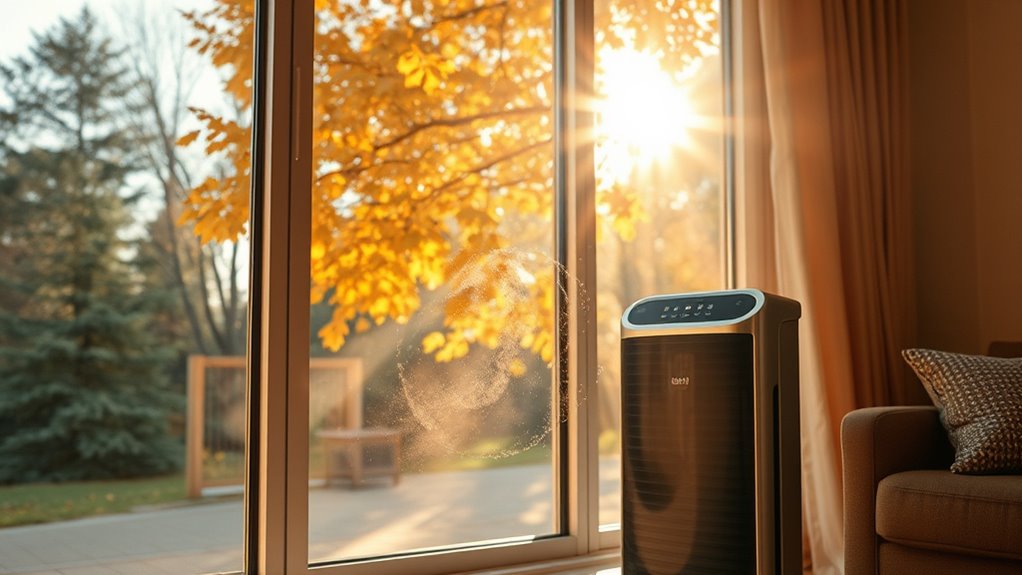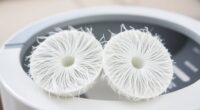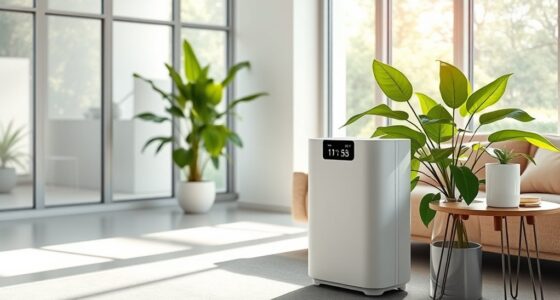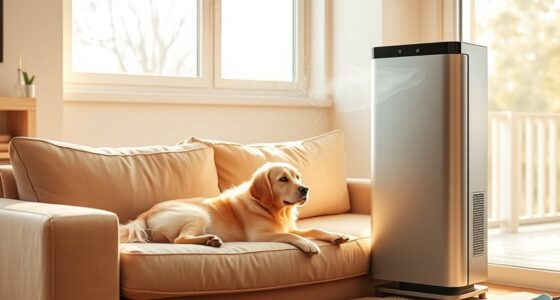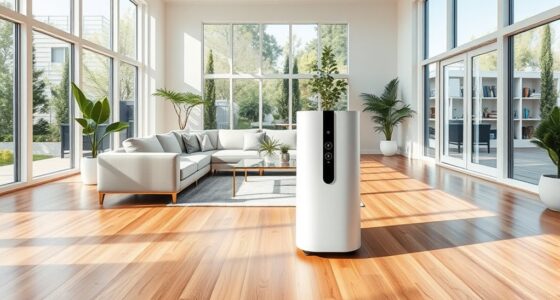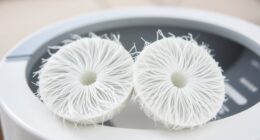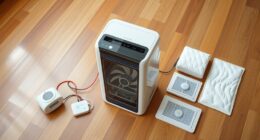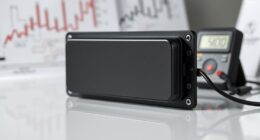During fall, air purifiers with HEPA and activated carbon filters can markedly improve your indoor air quality by trapping airborne pollen, mold spores, and dust mites that cause allergies. These filters work continuously to remove allergens, reduce odors, and prevent particles from settling or circulating. Using an air purifier helps ease allergy symptoms, promotes better sleep, and keeps your home healthier. To learn how to choose the right purifier for your needs, keep exploring.
Key Takeaways
- HEPA filters trap fall allergens like pollen, mold spores, and dust mites, reducing indoor allergen levels.
- Activated carbon filters absorb mold odors and airborne pollutants for a fresher indoor environment.
- Continuous air filtration minimizes allergen circulation, decreasing allergy symptoms and respiratory discomfort.
- Regular use of air purifiers prevents allergens from settling and being stirred up during cleaning or movement.
- Improving indoor air quality with air purifiers supports better sleep, comfort, and overall health during fall.
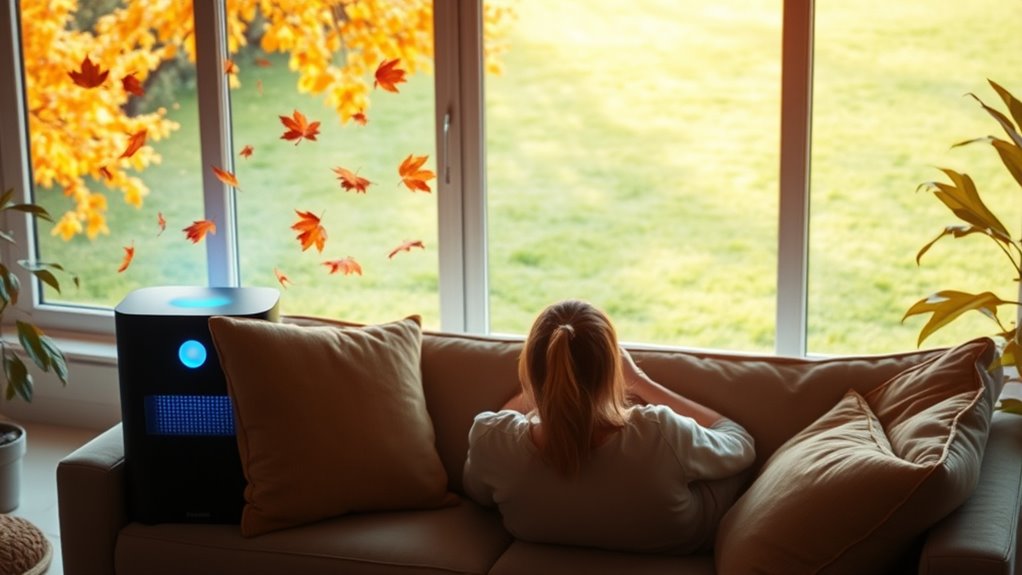
Seasonal allergens like pollen, mold spores, and dust mites can quickly turn your home into a battleground during allergy season. When these allergens are present, your indoor air quality suffers, making it harder to breathe comfortably and enjoy your daily activities. Luckily, air purifiers can be a game-changer, helping you maintain a cleaner, healthier environment and providing much-needed allergy relief. They work by trapping airborne particles, including those tiny allergens that trigger your symptoms, which means you can breathe easier and reduce your exposure indoors.
During fall, the prevalence of pollen from ragweed, grasses, and trees can be particularly intense. These particles cling to surfaces and float through the air, infiltrating your living spaces. An air purifier equipped with a HEPA filter can effectively capture these microscopic allergens, preventing them from circulating in your home. This considerably improves your indoor air quality, which is essential because many allergens tend to settle in carpets, upholstery, and bedding, only to be stirred up when you move around. By continuously filtering the air, your purifier minimizes these allergens’ presence, providing ongoing allergy relief.
HEPA filters trap pollen, reducing indoor allergens and improving air quality during fall allergy season.
Mold spores also become a concern in fall, especially as humidity levels fluctuate and damp environments promote mold growth. Mold spores are tiny and can easily become airborne, aggravating allergies and asthma. An air purifier with a HEPA filter can trap these spores before they reach your nose and lungs. Additionally, some models include activated carbon filters that absorb mold odors and other airborne pollutants, further enhancing your indoor air quality. Keeping mold spores at bay not only reduces allergy symptoms but also helps prevent respiratory issues associated with mold exposure.
Dust mites, often hidden deep in your bedding, curtains, and upholstered furniture, thrive in the fall when windows are closed and indoor heating is on. These microscopic pests are a common trigger for allergy symptoms. An air purifier can help reduce airborne dust mite debris, which contains allergenic proteins, by continuously cleaning the air in your living spaces. This improvement in air quality can lead to noticeable allergy relief, allowing you to sleep better and feel more comfortable during the season.
Frequently Asked Questions
Can Air Purifiers Remove Pollen From Outdoor Air Effectively?
You might wonder if air purifiers can remove outdoor pollen effectively. While they can’t filter pollen coming in through open windows, placing an air purifier indoors near entry points can reduce indoor pollen levels. Proper air purifier placement guarantees it captures outdoor pollen that enters your home, providing relief. Keep windows closed during high pollen seasons and use filters rated for pollen removal to maximize effectiveness.
How Often Should I Change the Filter During Fall Allergy Season?
You should change your air purifier’s filter every 1 to 3 months during fall allergy season. Check your filter’s lifespan and follow the maintenance schedule recommended by the manufacturer. If you notice reduced airflow or increased allergy symptoms, it’s time for a replacement. Regularly replacing the filter guarantees peak performance, helping you breathe easier and keep allergens like pollen and dust out of your indoor air during peak allergy times.
Are HEPA Filters Better Than Other Types for Allergy Relief?
Think of HEPA filters as the bodyguards of your air quality—they’re highly efficient at capturing tiny allergen particles. HEPA filters offer superior HEPA efficiency, making them better than other types for allergy relief. To keep them working at their best, regular filter maintenance is crucial. This ensures your air purifier continues to trap dust, pollen, and pet dander effectively, giving you cleaner, healthier air during allergy season.
Do Air Purifiers Also Eliminate Mold Spores and Dust Mites?
Air purifiers effectively reduce mold spores and dust mites in your home. HEPA filters trap these tiny particles, preventing them from circulating in the air you breathe. Regular use can considerably improve indoor air quality, especially if you’re sensitive to mold or dust mites. Make sure your air purifier has a true HEPA filter and run it consistently to keep these allergens at bay, creating a healthier living environment.
Can Air Purifiers Help With Allergy Symptoms at Night?
Think of your bedroom as Pandora’s box—filled with hidden irritants. An air purifier improves your bedroom air quality, helping you breathe easier at night. It captures pollen, dust, and mold spores, reducing allergy symptoms during your rest. When your nighttime breathing is clearer, you wake up refreshed. Using an air purifier creates a healthier sleep environment, ensuring you’re not just resting, but truly rejuvenating.
Conclusion
As fall’s golden leaves swirl and settle, let your air purifier be the steady lighthouse guiding you through the storm of seasonal allergens. It’s your silent guardian, clearing the invisible fog that threatens to cloud your breathing and cloud your days. Embrace the crisp air with confidence, knowing that with each breath, you’re steering clear of allergy’s grasp. Like a shield woven from clean air, your purifier keeps your sanctuary a haven amid nature’s swirling chaos.
